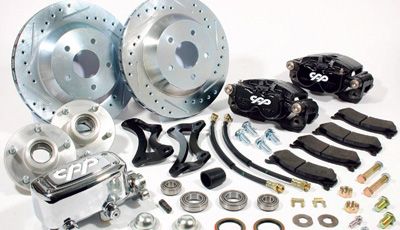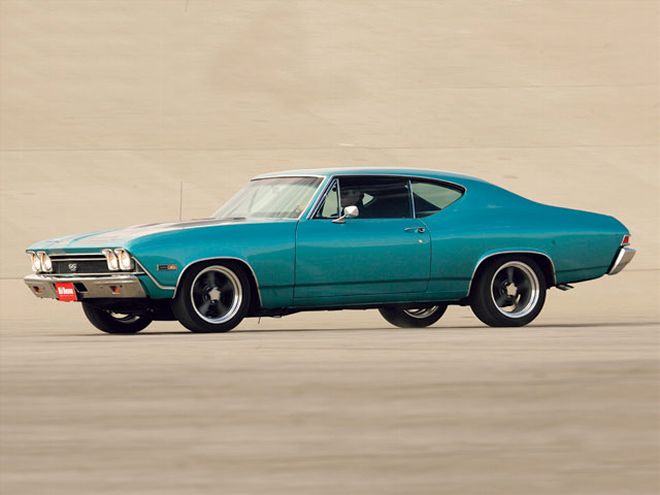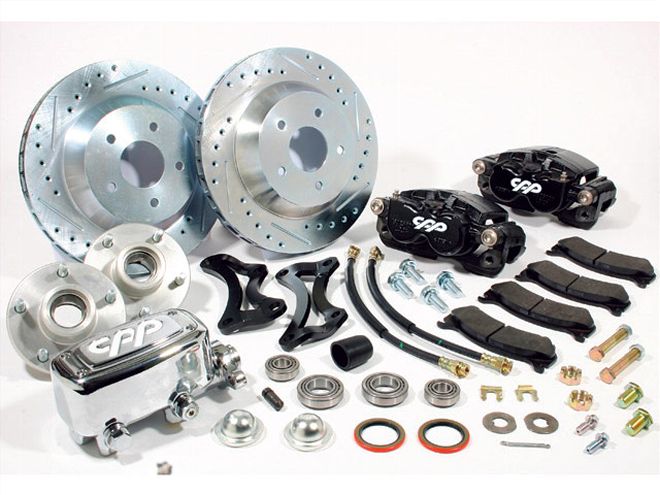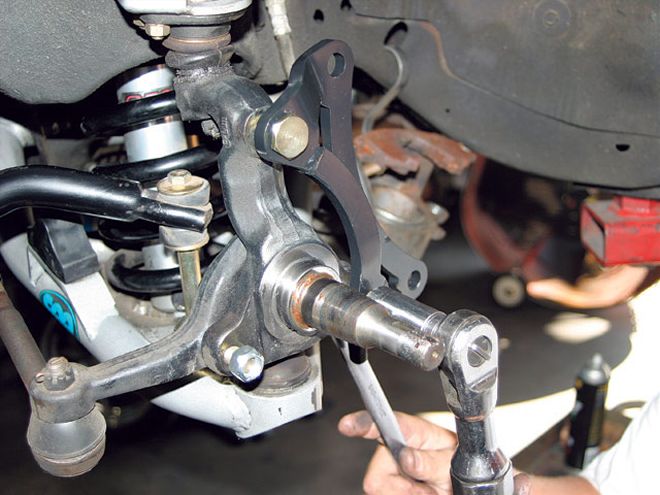

There's something disconcerting about pulling the trigger on a 600-plus-hp big-block, then stomping the stop pedal and getting no reaction. Our '68 Chevelle is the car in question, and with a curb weight approaching 3,700 pounds, there really isn't any excuse for having stock brakes. For the longest time we retained the stock brakes so we could use the 15-inch pizza-cutters up front. This helped us with our quarter-mile e.t., but was a thorn in the side around town.
 The front brake kit from CPP fits all '64-72 Chevelles (Part No. 6267WBK-P1, $799), and includes 13-inch rotors, dual 52mm piston calipers from PBR, hoses, hardware, mounting brackets, hubs, bearings, seals, cotter pins, pads, and instructions. The chrome master cylinder (part No. CP31500-C, $199) is not included, but if you're upgrading from drum brakes, it's recommended.
The front brake kit from CPP fits all '64-72 Chevelles (Part No. 6267WBK-P1, $799), and includes 13-inch rotors, dual 52mm piston calipers from PBR, hoses, hardware, mounting brackets, hubs, bearings, seals, cotter pins, pads, and instructions. The chrome master cylinder (part No. CP31500-C, $199) is not included, but if you're upgrading from drum brakes, it's recommended.
We finally said, "enough is enough!" The crappy stock brakes have to go, the dragstrip be damned. Since Classic Performance Products (CPP) supplied most of our suspension components, we gave them a call. It turns out they had exactly the budget-oriented front disc brake system we envisioned. CPP makes a very affordable ($799) system for '64-72 Chevelles that consists of 13-inch vented, cross-drilled, slotted, and zinc-washed rotors. These are paired with dual 52mm PBR pin-guided calipers. These are the same calipers that equip all '99-06 GM trucks and SUVs with six-lug wheels. That type of OE vehicle typically weighs up to 9,000 pounds, and has a towing capacity of 8,000 pounds, so you know those calipers are rated for severe duty.
The PBR calipers in the CPP kit take the same pads as all '99-06 GM six-lug SUV/trucks, so you can buy replacements at any AutoZone. The kit also includes caliper mounting brackets, brake lines, hoses, hubs, and all hardware. We also needed CPP's new master cylinder, due to the fact that our Chevelle was originally a manual drum brake car. The previous owner had made the conversion to stock manual disc brakes, but kept the smaller drum brake master cylinder. That's a no-no, especially since we were getting ready to increase our caliper bore diameter even more. That CPP master cylinder story will run at a later date.
 After removing your old brakes, start by installing the CPP caliper mounting bracket. Note that if you are converting from drums to discs, you'll first need to convert to disc brake spindles (Part No. 6474SP-S; $99, pair). Two bolts-a 3/8-inch upper anchor bolt, and a 1/2-inch lower mounting bolt-are a cinch.
After removing your old brakes, start by installing the CPP caliper mounting bracket. Note that if you are converting from drums to discs, you'll first need to convert to disc brake spindles (Part No. 6474SP-S; $99, pair). Two bolts-a 3/8-inch upper anchor bolt, and a 1/2-inch lower mounting bolt-are a cinch.
Brakes for Chevelles are pretty straightforward. All Chevelles used the same disc brake spindle, so one system fits all. What we didn't know is that Chevelles shared OEM brake components with Novas. Novas, being narrower and having more confined wheelwells, had to have a special narrow hub when equipped with the Chevelle's disc brakes from the factory. This means that a Nova disc brake hub can be used on a Chevelle in cases where wide wheel fitment calls for extra clearance. That was indeed the case with our 17x8-inch Vintage Wheel Works V40 wheels. Our brake kit included the "Nova" hubs, and carries the part number 6267WBK-P1 ($799).
Testing
Rarely do magazines test brake systems all-out; usually the tire is what limits the stopping power and the results. In our case, we already had a set of nitto nt01 r-compound tires, so the limiting factor in our "before" and "after" testing would truly be the brakes, not the rubber. We made a dozen 60-0-mph stops with the stock brakes, with the results ranging from 160 feet to a low of 137 feet. After the swap to the larger 13-inch rotors and larger calipers, we made a dozen more stops (after adjusting the built-in brake bias of our new cpp master cylinder). Results ranged from a high of 126 feet to a new best of 120 feet. Our best stop went from 137 to 120 feet, shaving 17 feet off the distance. Also, the big spread (over 20 feet) before the swap shows the negative effect of fade (heat) on small brakes, while the narrow spread (6 feet) after the swap shows how effectively the larger cpp brakes eliminate heat. And keep in mind, we were still running the late-model ford drum brakes in the back!